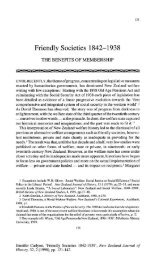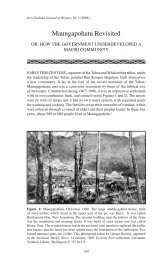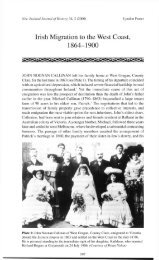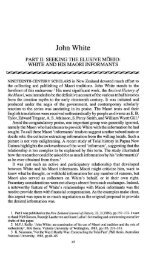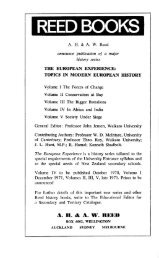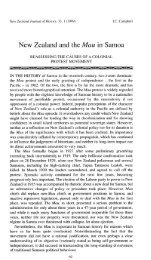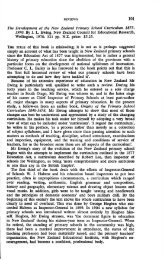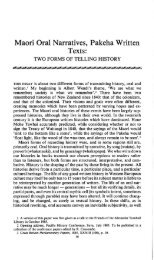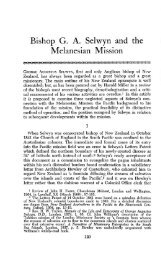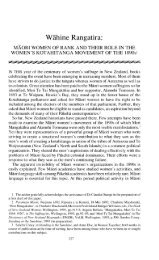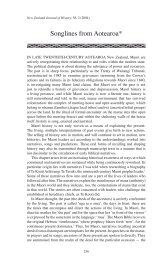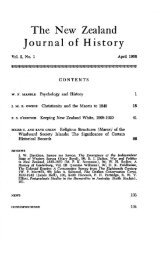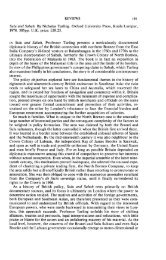a History of Broadcasting in New Zealand, Volume 1. By Patrick Day ...
a History of Broadcasting in New Zealand, Volume 1. By Patrick Day ...
a History of Broadcasting in New Zealand, Volume 1. By Patrick Day ...
You also want an ePaper? Increase the reach of your titles
YUMPU automatically turns print PDFs into web optimized ePapers that Google loves.
REVIEWS 113<br />
The Radio Years: a <strong>History</strong> <strong>of</strong> <strong>Broadcast<strong>in</strong>g</strong> <strong>in</strong> <strong>New</strong> <strong>Zealand</strong>, <strong>Volume</strong> <strong>1.</strong> <strong>By</strong> <strong>Patrick</strong> <strong>Day</strong>.<br />
Auckland University Press <strong>in</strong> association with the <strong>Broadcast<strong>in</strong>g</strong> <strong>History</strong> Trust, Auckland,<br />
1994. 352 pp. NZ price: $54.95. ISBN 1 -86940-094-<strong>1.</strong><br />
NEW ZEALAND HISTORIANS have picked over some bones pretty completely. The Land<br />
<strong>of</strong> the Long P<strong>in</strong>k Cloud has been done to death, <strong>of</strong> course. Various topics to do with<br />
women's and Maori experience now seem set to give that old nag a good run. And then<br />
there is broadcast<strong>in</strong>g, set at the <strong>in</strong>tersection between high culture, popular culture and<br />
politics. Many books — <strong>of</strong> vary<strong>in</strong>g quality — have told us how radio started and<br />
developed <strong>in</strong> this country. So do we need another history <strong>of</strong> <strong>New</strong> <strong>Zealand</strong> broadcast<strong>in</strong>g?<br />
Lay<strong>in</strong>g down the first part <strong>of</strong> Pat <strong>Day</strong>'s two-volume work the answer seems to be yes, but<br />
with some qualifications.<br />
This is the second book to be commissioned by that estimable body the <strong>Broadcast<strong>in</strong>g</strong><br />
<strong>History</strong> Trust (may its shadow never dim<strong>in</strong>ish!). As the sub-title suggests, the second<br />
volume (entitled Television Years, no doubt) will follow more or less tripp<strong>in</strong>gly from<br />
Auckland University Press. <strong>Day</strong> has been fortunate <strong>in</strong> his publisher. This book is<br />
beautifully produced, with no typographical errors speak<strong>in</strong>g to careful edit<strong>in</strong>g, with good<br />
paper, with a solid b<strong>in</strong>d<strong>in</strong>g and an uncluttered text. Many illustrations leaven <strong>Day</strong>'s<br />
words, though one needs a good lens to appreciate the po<strong>in</strong>t <strong>of</strong> many repr<strong>in</strong>ted cartoons.<br />
So what <strong>of</strong> the words between these illustrations? For those familiar with earlier<br />
broadcast<strong>in</strong>g histories, Radio Years is curiously conventional. The argument is strongly<br />
narrative, ordered chronologically around constitutional envelopes for <strong>New</strong> <strong>Zealand</strong><br />
radio. Pioneer<strong>in</strong>g days give way to the Radio <strong>Broadcast<strong>in</strong>g</strong> Company <strong>in</strong> the 1920s, then<br />
to the <strong>New</strong> <strong>Zealand</strong> <strong>Broadcast<strong>in</strong>g</strong> Board <strong>in</strong> the early 1930s and to the National <strong>Broadcast<strong>in</strong>g</strong><br />
Service and the National Commercial <strong>Broadcast<strong>in</strong>g</strong> Service — that extraord<strong>in</strong>ary<br />
adm<strong>in</strong>istrative cock-up — under the first Labour government. These two bodies merge<br />
<strong>in</strong> 1943 to form the <strong>New</strong> <strong>Zealand</strong> <strong>Broadcast<strong>in</strong>g</strong> Service; still rumbl<strong>in</strong>g on <strong>in</strong> 1960, when<br />
we stop. Different parts <strong>of</strong> this story pass us at different speeds. We reach 1930 somewhere<br />
around page 80; 1940, 160 pages later. The next 20 years whistle past <strong>in</strong> 65 pages, with<br />
the 1950s occupy<strong>in</strong>g no more than fourteen. Very clearly, <strong>in</strong> common with everybody<br />
else. <strong>Day</strong> takes the 1930s to be the key decade <strong>in</strong> radio broadcast<strong>in</strong>g.<br />
The argument may be conventional, but the documentation is not. <strong>Day</strong>'s long text<br />
allows him freedom to explore detail. To f<strong>in</strong>d this detail he m<strong>in</strong>ed parliamentary,<br />
company and departmental records, together with a range <strong>of</strong> archived personal papers.<br />
His bibliography is surpris<strong>in</strong>gly short — thesis literature is entirely absent, for <strong>in</strong>stance<br />
—but primary evidence fills that space. This evidence clarifies important detail. We learn<br />
much more about technical development than we knew before. Political deals beh<strong>in</strong>d<br />
found<strong>in</strong>g the Radio <strong>Broadcast<strong>in</strong>g</strong> Company, beh<strong>in</strong>d jamm<strong>in</strong>g Col<strong>in</strong> Scrimgeour's 1ZB<br />
broadcast <strong>in</strong> the run-up to the 1935 general election, beh<strong>in</strong>d Scrim's sack<strong>in</strong>g eight years<br />
later, emerge <strong>in</strong> all their grubby facticity. Students and scholars follow<strong>in</strong>g his tracks will<br />
f<strong>in</strong>d this detail very useful: certa<strong>in</strong>ly I learnt much about th<strong>in</strong>gs which I thought I knew.<br />
That said, this is not a book which will entice the general reader. Radio Years is no<br />
Radio <strong>Day</strong>s, and Pat <strong>Day</strong> is no Woody Allen. The po<strong>in</strong>t is more than a mere pun. Given<br />
how many others have trodden this path before him, <strong>in</strong> however scanty a fashion, it would<br />
have been welcome to have a study that cut <strong>in</strong>to this history from a new direction. This<br />
was not to be. The <strong>in</strong>troduction promises a study <strong>of</strong> the relationship between the growth<br />
<strong>of</strong> broadcast<strong>in</strong>g and 'the chang<strong>in</strong>g nature <strong>of</strong> the society that adopted the medium'. We hear<br />
much <strong>of</strong> the former but surpris<strong>in</strong>gly little <strong>of</strong> the latter, particularly when the author earns<br />
his honest crust as a sociologist. To a large extent this rema<strong>in</strong>s broadcast<strong>in</strong>g history from
114 REVIEWS<br />
the <strong>in</strong>side, concerned with transmitt<strong>in</strong>g equipment; with policy decisions about the proper<br />
(or the most expedient) relation between politicians, adm<strong>in</strong>istrators and private companies;<br />
about balanc<strong>in</strong>g national, regional and local control; about the viability <strong>of</strong> a dual<br />
mandate to <strong>in</strong>form while enterta<strong>in</strong><strong>in</strong>g. Even when discuss<strong>in</strong>g these matters, the book's<br />
strong narrative cast thrusts analysis to the marg<strong>in</strong>.<br />
That does not mean that there is no analysis, <strong>of</strong> course. Rather, judgements slide <strong>in</strong><br />
among the detail. Once aga<strong>in</strong>, the judgements are conventional. It is not altogether easy<br />
to appreciate as the detail unrolls <strong>in</strong>exorably, but the climax <strong>of</strong> <strong>Day</strong>' s argument is the long<br />
battle between Col<strong>in</strong> Scrimgeour, director <strong>of</strong> the National Commercial <strong>Broadcast<strong>in</strong>g</strong><br />
Service, and the director <strong>of</strong> the National <strong>Broadcast<strong>in</strong>g</strong> Service, James Shelley. Rest<strong>in</strong>g on<br />
Long P<strong>in</strong>k Cloud historiography and an attachment to popular culture, our author's heart<br />
is with the doomed Scrim. No problem with that, except that Shelley then is constructed<br />
as the antithesis <strong>of</strong> Scrim. Scrim is a simple populist so Shelley becomes 'Reithian', code<br />
for a simple elitist. Scrim is on the left, so Shelley must be some k<strong>in</strong>d <strong>of</strong> Tory. This is a<br />
travesty <strong>of</strong> the truth about that extraord<strong>in</strong>ary, complicated, contradictory man; but it<br />
po<strong>in</strong>ts to a more significant matter. As a glance at the pages <strong>of</strong> Tomorrow would have told<br />
him, cultural politics <strong>in</strong> the 1930s (and, <strong>of</strong> course, <strong>in</strong> other decades also) were much more<br />
subtle and complicated than <strong>Day</strong>' s account suggests. A leftist political project could seek<br />
to appropriate high culture and turn it to 'the people's' use, as the history <strong>of</strong> the WEA<br />
demonstrates. <strong>Day</strong>'s conflation between leftist politics and popular culture needs a<br />
justification that it does not get.<br />
Analys<strong>in</strong>g these matters — and there are others equally merit<strong>in</strong>g our attention — needs<br />
sharper tools than those employed here. Perhaps we will f<strong>in</strong>d them used as <strong>Day</strong> strides<br />
onwards and upwards toward the television years. Perhaps that will not happen, and other<br />
scholars will have to tell us what the history <strong>of</strong> <strong>New</strong> <strong>Zealand</strong> radio means; but even they<br />
will be forced to build their explanations from bricks manufactured <strong>in</strong> this magisterial<br />
summary <strong>of</strong> the evidence.<br />
The University <strong>of</strong><br />
Auckland<br />
IAN CARTER<br />
Wire and Wireless: A <strong>History</strong> <strong>of</strong> Telecommunications <strong>in</strong> <strong>New</strong> <strong>Zealand</strong>, 1860-1987. <strong>By</strong><br />
A.C. Wilson. Dunmore Press, Palmerston North, 1994, 236 pp. NZ price: $39.95, ISBN<br />
0-86469-210-2.<br />
THE FOCUS <strong>of</strong> this work is at once narrower and wider than its title suggests. It does not<br />
cover the whole field <strong>of</strong> telecommunications, referr<strong>in</strong>g only briefly to the development<br />
<strong>of</strong> radio and television broadcast<strong>in</strong>g. Nor does it say much about the systems <strong>of</strong><br />
communication operated by government departments other than the Post Office, <strong>in</strong>clud<strong>in</strong>g<br />
railways, mar<strong>in</strong>e, defence and civil aviation, or the numerous private telephone<br />
systems that operated for a time. Conversely, about a third <strong>of</strong> Wire and Wireless goes back<br />
well beyond its declared start<strong>in</strong>g po<strong>in</strong>t <strong>of</strong> 1890 to deal with the beg<strong>in</strong>n<strong>in</strong>gs <strong>of</strong> telegraphy<br />
and telephony <strong>in</strong> <strong>New</strong> <strong>Zealand</strong>. This is fortunate, as 1890 does not constitute a logical<br />
break <strong>in</strong> the story, and a survey <strong>of</strong> the forces promot<strong>in</strong>g and delay<strong>in</strong>g the early spread <strong>of</strong><br />
these technologies is welcome.<br />
Wilson presents the development <strong>of</strong> telecommunications <strong>in</strong> <strong>New</strong> <strong>Zealand</strong> as the



